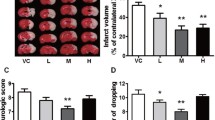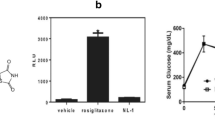Abstract
Disturbances in intracellular iron homeostasis are associated with neuronal injury after stroke. However, exposure of cells to classical chelators may interfere with physiological iron functions. BHAPI is an iron prochelator that exerts strong iron binding capacity only under oxidative stress conditions. This study investigated the protective effects of N′-(1-(2-((4-(4,4,5,5-tetramethyl-1,2,3-dioxoborolan-2-yl)benzyl)oxy)phenyl)ethylidene (BHAPI) on an in vitro ischemia model mimicked by oxygen and glucose deprivation (OGD) in neuronal HT22 cells. The results showed that BHAPI significantly increased cell viability and decreased lactate dehydrogenase (LDH) release after OGD. BHAPI treatment also reduced apoptosis, as measured by flow cytometry, and suppressed caspase-3 activation. These protective effects were accompanied by preserved mitochondrial membrane potential (MMP), reduced mitochondrial swelling, promoted mitochondrial calcium buffering capacity, and increased mitochondrial respiration. The results of MitoTracker staining showed that BHAPI partially prevented the OGD-induced changes in mitochondrial morphology. Furthermore, BHAPI selectively increased the expression of mitochondrial dynamic protein Mfn2, with no effect on Mfn1 expression. Knockdown of Mfn2 with specific siRNA partially reversed the protective effects of BHAPI. In summary, the iron prochelator BHAPI protects HT22 cells against ischemic injury through preservation of mitochondrial function and Mfn2 signaling.




Similar content being viewed by others
References
Andersen HH, Johnsen KB, Moos T (2014) Iron deposits in the chronically inflamed central nervous system and contributes to neurodegeneration. Cell Mol Life Sci 71:1607–1622
Anne Stetler R, Leak RK, Gao Y, Chen J (2013) The dynamics of the mitochondrial organelle as a potential therapeutic target. J Cereb Blood Flow Metab 33:22–32
Archer SL (2013) Mitochondrial dynamics—mitochondrial fission and fusion in human diseases. N Engl J Med 369:2236–2251
Baxter P, Chen Y, Xu Y, Swanson RA (2014) Mitochondrial dysfunction induced by nuclear poly(ADP-ribose) polymerase-1: a treatable cause of cell death in stroke. Transl Stroke Res 5:136–144
Calo L, Dong Y, Kumar R, Przyklenk K, Sanderson TH (2013) Mitochondrial dynamics: an emerging paradigm in ischemia-reperfusion injury. Curr Pharm Des 19:6848–6857
Chang DT, Reynolds IJ (2006) Mitochondrial trafficking and morphology in healthy and injured neurons. Prog Neurobiol 80:241–268
Chen T, Liu W, Chao X, Qu Y, Zhang L, Luo P, Xie K, Huo J, Fei Z (2011) Neuroprotective effect of osthole against oxygen and glucose deprivation in rat cortical neurons: involvement of mitogen-activated protein kinase pathway. Neuroscience 183:203–211
Chen T, Fei F, Jiang XF, Zhang L, Qu Y, Huo K, Fei Z (2012) Down-regulation of Homer1b/c attenuates glutamate-mediated excitotoxicity through endoplasmic reticulum and mitochondria pathways in rat cortical neurons. Free Radic Biol Med 52:208–217
Chen T, Yang YF, Luo P, Liu W, Dai SH, Zheng XR, Fei Z, Jiang XF (2013) Homer1 knockdown protects dopamine neurons through regulating calcium homeostasis in an in vitro model of Parkinson’s disease. Cell Signal 25:2863–2870
Crichton RR, Dexter DT, Ward RJ (2011) Brain iron metabolism and its perturbation in neurological diseases. J Neural Transm (Vienna) 118:301–314
Dong G, Chen T, Ren X, Zhang Z, Huang W, Liu L, Luo P, Zhou H (2016) Rg1 prevents myocardial hypoxia/reoxygenation injury by regulating mitochondrial dynamics imbalance via modulation of glutamate dehydrogenase and mitofusin 2. Mitochondrion 26:7–18
Feigin VL, Forouzanfar MH, Krishnamurthi R, Mensah GA, Connor M, Bennett DA, Moran AE, Sacco RL, Anderson L, Truelsen T, O'Donnell M, Venketasubramanian N, Barker-Collo S, Lawes CM, Wang W, Shinohara Y, Witt E, Ezzati M, Naghavi M, Murray C (2014) Global and regional burden of stroke during 1990-2010: findings from the Global Burden of Disease Study 2010. Lancet 383:245–254
Feng Y, LeBlanc MH, LeBlanc EB, Parker CC, Fratkin JD, Qian XB, Patel DM, Huang M, Smith EE, Vig PJ (2000) Desmethyl tirilazad improves neurologic function after hypoxic ischemic brain injury in piglets. Crit Care Med 28:1431–1438
Ferree A, Shirihai O (2012) Mitochondrial dynamics: the intersection of form and function. Adv Exp Med Biol 748:13–40
Galey JB (2001) Recent advances in the design of iron chelators against oxidative damage. Mini Rev Med Chem 1:233–242
Galey JB, Dumats J, Beck I, Fernandez B, Hocquaux M (1995) N,N'-bis-dibenzyl ethylenediaminediacetic acid (DBED): a site-specific hydroxyl radical scavenger acting as an “oxidative stress activatable” iron chelator in vitro. Free Radic Res 22:67–86
Hall ED (1992) Novel inhibitors of iron-dependent lipid peroxidation for neurodegenerative disorders. Ann Neurol 32(Suppl):S137–S142
Hankey GJ (2013) The global and regional burden of stroke. Lancet Glob Health 1:e239–e240
Haskova P, Kovarikova P, Koubkova L, Vavrova A, Mackova E, Simunek T (2011) Iron chelation with salicylaldehyde isonicotinoyl hydrazone protects against catecholamine autoxidation and cardiotoxicity. Free Radic Biol Med 50:537–549
Haskova P, Jansova H, Bures J, Machacek M, Jirkovska A, Franz KJ, Kovarikova P, Simunek T (2016) Cardioprotective effects of iron chelator HAPI and ROS-activated boronate prochelator BHAPI against catecholamine-induced oxidative cellular injury. Toxicology 371:17–28
Hoppins S, Lackner L, Nunnari J (2007) The machines that divide and fuse mitochondria. Annu Rev Biochem 76:751–780
Hruskova K, Kovarikova P, Bendova P, Haskova P, Mackova E, Stariat J, Vavrova A, Vavrova K, Simunek T (2011) Synthesis and initial in vitro evaluations of novel antioxidant aroylhydrazone iron chelators with increased stability against plasma hydrolysis. Chem Res Toxicol 24:290–302
Huang FP, Xi G, Keep RF, Hua Y, Nemoianu A, Hoff JT (2002) Brain edema after experimental intracerebral hemorrhage: role of hemoglobin degradation products. J Neurosurg 96:287–293
Kielar F, Helsel ME, Wang Q, Franz KJ (2012) Prochelator BHAPI protects cells against paraquat-induced damage by ROS-triggered iron chelation. Metallomics 4:899–909
Krishnamurthi RV, Feigin VL, Forouzanfar MH, Mensah GA, Connor M, Bennett DA, Moran AE, Sacco RL, Anderson LM, Truelsen T, O'Donnell M, Venketasubramanian N, Barker-Collo S, Lawes CM, Wang W, Shinohara Y, Witt E, Ezzati M, Naghavi M, Murray C (2013) Global and regional burden of first-ever ischaemic and haemorrhagic stroke during 1990-2010: findings from the Global Burden of Disease Study 2010. Lancet Glob Health 1:e259–e281
Liesa M, Palacin M, Zorzano A (2009) Mitochondrial dynamics in mammalian health and disease. Physiol Rev 89:799–845
Ma J, You C, Hao L, (2012) Iron chelators for acute stroke. Cochrane Database Syst Rev 9:CD009280
Millan M, Sobrino T, Castellanos M, Nombela F, Arenillas JF, Riva E, Cristobo I, Garcia MM, Vivancos J, Serena J, Moro MA, Castillo J, Davalos A (2007) Increased body iron stores are associated with poor outcome after thrombolytic treatment in acute stroke. Stroke 38:90–95
Misko AL, Sasaki Y, Tuck E, Milbrandt J, Baloh RH (2012) Mitofusin2 mutations disrupt axonal mitochondrial positioning and promote axon degeneration. J Neurosci 32:4145–4155
Ong SB, Hall AR, Hausenloy DJ (2013) Mitochondrial dynamics in cardiovascular health and disease. Antioxid Redox Signal 19:400–414
Oubidar M, Boquillon M, Marie C, Schreiber L, Bralet J (1994) Ischemia-induced brain iron delocalization: effect of iron chelators. Free Radic Biol Med 16:861–867
Pelizzoni I, Macco R, Zacchetti D, Grohovaz F, Codazzi F (2008) Iron and calcium in the central nervous system: a close relationship in health and sickness. Biochem Soc Trans 36:1309–1312
Peng C, Rao W, Zhang L, Wang K, Hui H, Wang L, Su N, Luo P, Hao YL, Tu Y, Zhang S, Fei Z (2015) Mitofusin 2 ameliorates hypoxia-induced apoptosis via mitochondrial function and signaling pathways. Int J Biochem Cell Biol 69:29–40
Prentice H, Modi JP, Wu JY (2015) Mechanisms of neuronal protection against excitotoxicity, endoplasmic reticulum stress, and mitochondrial dysfunction in stroke and neurodegenerative diseases. Oxidative Med Cell Longev 2015:964518
Qian W, Van Houten B (2010) Alterations in bioenergetics due to changes in mitochondrial DNA copy number. Methods 51:452–457
Rego AC, Oliveira CR (2003) Mitochondrial dysfunction and reactive oxygen species in excitotoxicity and apoptosis: implications for the pathogenesis of neurodegenerative diseases. Neurochem Res 28:1563–1574
Sacco RL, Kasner SE, Broderick JP, Caplan LR, Connors JJ, Culebras A, Elkind MS, George MG, Hamdan AD, Higashida RT, Hoh BL, Janis LS, Kase CS, Kleindorfer DO, Lee JM, Moseley ME, Peterson ED, Turan TN, Valderrama AL, Vinters HV (2013) An updated definition of stroke for the 21st century: a statement for healthcare professionals from the American Heart Association/American Stroke Association. Stroke 44:2064–2089
Santel A, Frank S, Gaume B, Herrler M, Youle RJ, Fuller MT (2003) Mitofusin-1 protein is a generally expressed mediator of mitochondrial fusion in mammalian cells. J Cell Sci 116:2763–2774
Selim MH, Ratan RR (2004) The role of iron neurotoxicity in ischemic stroke. Ageing Res Rev 3:345–353
Westermann B (2010) Mitochondrial fusion and fission in cell life and death. Nat Rev Mol Cell Biol 11:872–884
Yu Z, Liu N, Li Y, Xu J, Wang X (2013) Neuroglobin overexpression inhibits oxygen-glucose deprivation-induced mitochondrial permeability transition pore opening in primary cultured mouse cortical neurons. Neurobiol Dis 56:95–103
Zhao N, Zhang Y, Liu Q, Xiang W (2015) Mfn2 affects embryo development via mitochondrial dysfunction and apoptosis. PLoS One 10:e0125680
Author information
Authors and Affiliations
Corresponding author
Ethics declarations
Conflict of Interest
The authors declare that they have no conflict of interest.
Rights and permissions
About this article
Cite this article
Chen, XL., Zhang, GP., Guo, SL. et al. Mfn2-Mediated Preservation of Mitochondrial Function Contributes to the Protective Effects of BHAPI in Response to Ischemia. J Mol Neurosci 63, 267–274 (2017). https://doi.org/10.1007/s12031-017-0976-z
Received:
Accepted:
Published:
Issue Date:
DOI: https://doi.org/10.1007/s12031-017-0976-z




